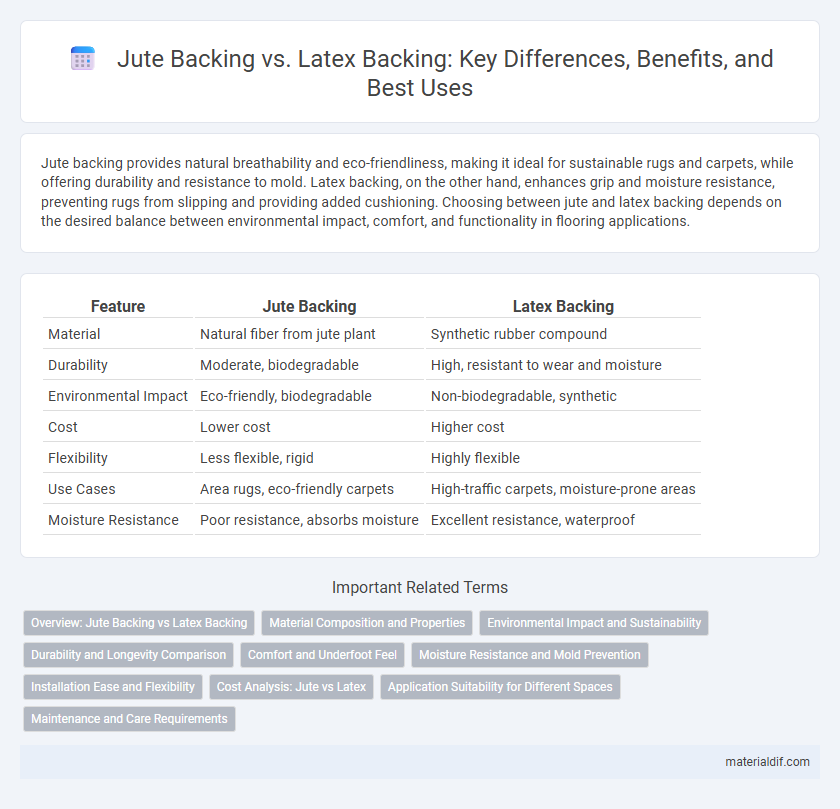Jute backing provides natural breathability and eco-friendliness, making it ideal for sustainable rugs and carpets, while offering durability and resistance to mold. Latex backing, on the other hand, enhances grip and moisture resistance, preventing rugs from slipping and providing added cushioning. Choosing between jute and latex backing depends on the desired balance between environmental impact, comfort, and functionality in flooring applications.
Table of Comparison
| Feature | Jute Backing | Latex Backing |
|---|---|---|
| Material | Natural fiber from jute plant | Synthetic rubber compound |
| Durability | Moderate, biodegradable | High, resistant to wear and moisture |
| Environmental Impact | Eco-friendly, biodegradable | Non-biodegradable, synthetic |
| Cost | Lower cost | Higher cost |
| Flexibility | Less flexible, rigid | Highly flexible |
| Use Cases | Area rugs, eco-friendly carpets | High-traffic carpets, moisture-prone areas |
| Moisture Resistance | Poor resistance, absorbs moisture | Excellent resistance, waterproof |
Overview: Jute Backing vs Latex Backing
Jute backing is a natural fiber known for its eco-friendliness, breathability, and durability, often used in rugs and carpets to provide sturdy support and enhanced texture. Latex backing offers superior moisture resistance and added flexibility, making it ideal for preventing slippage and maintaining shape in high-traffic areas. Choosing between jute and latex backing depends on factors such as environmental impact, moisture exposure, and desired rug stability.
Material Composition and Properties
Jute backing consists of natural fibers derived from the jute plant, providing a breathable, eco-friendly, and biodegradable foundation that enhances carpet durability while maintaining flexibility. Latex backing, made from synthetic rubber materials, offers superior water resistance, increased adhesion, and improved elasticity but lacks the natural biodegradability of jute. The contrasting properties in moisture resistance and environmental impact make jute backing preferable for sustainable applications, whereas latex backing suits high-performance, moisture-prone environments.
Environmental Impact and Sustainability
Jute backing is highly sustainable due to its natural, biodegradable fibers derived from renewable plant sources, significantly reducing landfill waste. Latex backing, often made from synthetic materials or processed natural rubber, can release harmful chemicals during production and degradation, impacting environmental health. Choosing jute backing supports eco-friendly carpet manufacturing by minimizing carbon footprint and promoting soil-friendly cultivation practices.
Durability and Longevity Comparison
Jute backing offers moderate durability, suitable for low-traffic areas, while latex backing provides enhanced resilience and improved longevity under heavy foot traffic. Latex backing resists moisture and mold better than jute, extending the lifespan of rugs in humid or frequently cleaned environments. Rugs with latex backing retain shape and structure longer, reducing wear and tear over time compared to jute-backed alternatives.
Comfort and Underfoot Feel
Jute backing offers a natural, breathable foundation that enhances comfort by allowing air circulation and providing a firm but cushioned underfoot feel. Latex backing delivers superior grip and a softer, more flexible cushion, improving overall comfort by reducing fatigue during prolonged standing or walking. Choosing between jute and latex backing depends on the desired balance between natural breathability and enhanced cushioning for underfoot comfort.
Moisture Resistance and Mold Prevention
Jute backing offers natural breathability but tends to absorb moisture, increasing the risk of mold growth in humid environments. Latex backing provides superior moisture resistance by creating a waterproof barrier that prevents water infiltration and inhibits mold development. Choosing latex backing is ideal for areas prone to moisture, ensuring enhanced durability and mold prevention in flooring applications.
Installation Ease and Flexibility
Jute backing offers superior flexibility, making it easier to install on uneven surfaces and curved areas due to its natural pliability. Latex backing provides excellent adhesion and durability but can be less forgiving during installation, especially on irregular floors. Choosing jute backing enhances ease of handling and reduces installation time, particularly in complex layouts.
Cost Analysis: Jute vs Latex
Jute backing is generally more cost-effective than latex backing due to its natural fiber composition and lower production expenses, making it a budget-friendly option for carpet manufacturers. Latex backing, while offering superior durability and moisture resistance, incurs higher material and processing costs that translate to increased product prices. Choosing jute backing can reduce overall expenditure but may compromise on longevity compared to the more expensive, heavy-duty latex backing.
Application Suitability for Different Spaces
Jute backing offers natural breathability and eco-friendly properties, making it ideal for low-traffic residential areas where moisture control is essential. Latex backing provides enhanced durability and moisture resistance, suited for high-traffic commercial spaces and areas prone to spills. Selecting between jute and latex backing depends on the balance of environmental impact, durability requirements, and the specific demands of the installation environment.
Maintenance and Care Requirements
Jute backing requires gentle vacuuming and occasional spot cleaning to prevent fiber damage, as it is more susceptible to moisture and mold growth. Latex backing offers enhanced durability and moisture resistance, allowing for easier maintenance with regular vacuuming and occasional damp cloth cleaning. Choosing latex backing reduces the risk of backing deterioration and extends the rug's lifespan in high-traffic or humid environments.
Jute Backing vs Latex Backing Infographic

 materialdif.com
materialdif.com